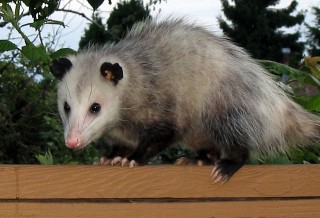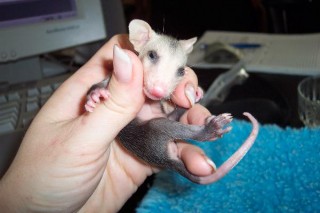
An adult possum weighs from four to ten pounds and is about the size of a housecat. They are good climbers and use their semi-prehensile tail to help them move about in trees. Their most amazing characteristic is the ability to feign death or “play possum.” Wikimedia photo.
The opossum has gotten a bad rap. Some of the mean things people say about ‘possums are: They are ugly. They are big rats. They are vicious. They dig up your flowerbeds. They get into your garbage cans.
Most of these statements aren’t at all true. Of course, some folks do consider them “ugly.” But even that is in the eye of the beholder.
Although opossums are somewhat rat-like in appearance, they are not rodents. They belong to the oldest, most primitive group of mammals: the marsupials. Marsupials are mammals that raise their young in a pouch on the female’s abdomen. You are familiar with kangaroos and koalas, marsupial mammals found only in Australia. Opossums are their close cousins in North and South America.
The Americas are home to more than sixty species of opossums. But only one species, the Virginia Opossum, (Didelphis virginiana), is found in North America. This is the species of possum we all know and love (or not). It is our only marsupial.
Since it is “one of a kind” in our area, you would think we would hold it in high regard. Unfortunately for the possum, most of us consider it a form of vermin. It is an animal we want to exclude from our yards, and especially from our homes.
But are possums all that bad? After doing a bit of investigating, I don’t think so. They are normally denizens of deciduous forests and wooded creeks. But they have adapted to parks, farmlands and even suburbia. They are nocturnal and venture out to feed just after dark. Their diet is varied; they feed on insects, small mammals, birds, reptiles, snails and crawfish. When fruit and berries are available, possums readily partake of these foods. Carrion is often a large part of their diet. You can see that they are opportunists when it comes to food.

This baby opossum is at the age when it can detach from a nipple in the mother’s pouch and begin to ride around on its mother’s back. Some people consider possums to be ugly, vicious vermin. But at this stage, they are cute. Wikimedia photo.
So, yes, they will gladly go through your garbage. However, they are usually not the culprits that open the garbage cans. More often, raccoons are the ones that begin the raid. Raccoons take what they want and then run off leaving the slower creatures to take the blame. Possums are generally not capable of opening lids. They do have opposable thumbs, but these thumbs are on their hind feet. I doubt that a possum could lever open a lid or undo a latch with its back feet. But if it is already open and food scattered, possums will go for it.
The same is true for pet food left outside at night. To a possum, dishes of kibble are easy pickings!
During the day, possums den up in hollow trees or logs, or in rock crevices or woodpiles, and under buildings. They aren’t much good at digging burrows for themselves but they will occupy an abandoned burrow made by some other animal. In this sense, they are again opportunists. I once found a sleeping possum curled up in a broken, hollow cemetery monument. If it fits, they will use it.
If you see a possum in your backyard, you needn’t worry. It will lumber along, eating whatever, and then go back to its den. They do not dig for food. Possums will clean up fallen fruit and any small carrion they find. This habit makes them nature’s handy little sanitation engineers!
Possums found where you really don’t want them to be (such as in your garage) can be herded away with a broom. But don’t corner them. A cornered wild possum is a frightened animal. It will bare its teeth and hiss. It looks vicious because it has so many teeth: 50 teeth in all. Remember, it is much more afraid of you than you are of it.
Possums have an unusual behavior. I am sure you have heard that when threatened they can fall down and act dead. This is known as “playing possum” and it is very convincing. The possum will keel over suddenly, pull back its lips from its many teeth, drool, and appear to be unconscious. It may release foul-smelling liquid from its anal glands. You and other predators are pretty much put off by this behavior and will leave the possum alone. After as few as 40 minutes and as long as four hours, the “dead” possum will wiggle its ears, wake up, and walk away.
Playing possum seems to be involuntary. Some sources say it is rather like fainting. The animal has no control over when it will fall over or when it will revive. Some possums feigning death appear to be almost in a coma. It is indeed an odd behavior.
Another odd thing about this animal is its reproduction. Females have two uteri. In fact, the genus name, Didelphis means double –uterus. In about 12 days after fertilization the female possum gives birth to up to 20 very embryonic babies. The honey bee-sized babies must crawl to their mother’s pouch and attach to a nipple in order to survive. However, there are only 13 nipples. Baby possums that don’t get a nipple are doomed to die. Oddly, the nipples are arranged in a circle of twelve with one more in the center of the circle. How in the world did that evolve?
Baby opossums are called joeys, like kangaroo babies. The joeys spend the first seven weeks of their lives attached the nipples. After that they detach and come and go from the pouch for another few weeks. Older joeys cling tightly to the back fur of the mother; they go where she goes until they are about four months old.
The long, nearly naked tail of a possum is semi-prehensile. It is used to help the possum move about in trees. Possums can use it to grab a bunch of twigs and leaves carry them to its burrow. They cannot hang by the tail, however, at least not once they are grown. The tail is not strong enough to hold the weight of a full grown possum.
So give the poor possum some respect. These odd, toothy, death-feigning, prehensile-tailed animals are fascinating in so many ways.
ESSAY BY KAREN L. P. BENSON
If you would like to receive Karen’s Nature Essays by email, please signup here.
